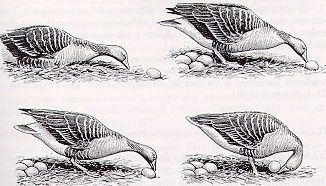ABSTRACT:
In this lab, animal behavior relative to the organism's environment is being observed. In this experiment, Armadillidiidaes (pillbugs) are observed in order to find out their preferences on types of environment. Humidity and acidity/taste are used as two of the factors in this experiment. The results showed that the pillbugs tend to prefer a more moist environment to a dry one. It also revealed that pillbugs highly prefer environments without acidity (basic)
INTRODUCTION:
Behavior is the way in which one acts or conducts oneself in a set environment. Proximate and ultimate causes also apply to animal behavior. Proximate cause is the immediate trigger for a certain behavior in an animal. Ultimate cause is the evolutionary purpose or reason the animal behaves the way it does. For example in bird song, "why is the bird singing?" would be a proximate question for that certain behavior. An ultimate question for the same behavior would be "what is the evolutionary purpose for a bird to sing?"
http://www.showziji.com/wp-content/uploads/2014/03/wallpapers-bird-singing-animals-nature-landscapes-images-singing-birds-hd-wallpaper.jpg
In ethology, a fixed action pattern is the instinctive behavior that is unchangeable and invariant. These behaviors are produced by a neural network called the innate releasing mechanism in response to an external sensory stimulus called the sign stimulus. This type of behavior is "hard-wired" and instinctive in the animal.
http://www.realclearscience.com/blog/pato.jpg
Imprinting is a type of psychological behavior best defined as any sort of phase-sensitive learning, which is a type of learning that occurs at a specific age or specific stage in life). It develops rapidly and is completely independent from behavior. Imprinting is described as when an animal or person learns specific behaviors or characteristics of a certain stimulus. A proximate cause for imprinting in young geese is the instinctive and innate response to imprint during the critical period (a time early in animal's life when it forms attachments and develops its own identity) in order to recognize its parent and its own species. The ultimate cause of filial imprinting in young geese is the need to acquire behavioral characteristics from its parent in order to survive and ensure that it will have the best opportunity of minimizing threats of survival (lack of food, predators, etc).
http://anchaesmicasa.files.wordpress.com/2010/12/imprinting.jpg
Taxis is a specific and directed motion in response to a stimulus. Taxis involves motion in the direction of a stimulus (positive taxis) or away from a stimulus (negative taxis). An example of taxis is when a male moth flies specifically in the direction of a female moth in response to her pheremones so that it can find a potential mate. Kinesis is a random and undirected response to a stimulus. An example of kenesis is when one turns on the lights and cockroaches scatter in any direction. Instead of going towards or away from a stimulus (light), it just causes them to go in whichever random direction.
http://bio1151b.nicerweb.net/Locked/media/ch51/51_07Kinesis.jpg
A famous example of classical conditioning is Ivan Pavlov's experiment with dogs. Pavlov noticed that dogs began to salivate in response to a sound that has been paired with the presentation or symbol of food. He soon realized that this was a learned response. Classical conditioning involves a neutral stimulus (sound of a bag of dog treats rattling) with an unconditioned stimulus (taste of dog treats). The unconditioned stimulus then naturally triggers an unconditioned response, salivating. It is a type of learned behavior when a conditioned stimulus is paired with an unconditioned stimulus. Operant conditioning, on the other hand, focuses on using reinforcement and punishment to increase or decrease a certain behavior. An example of this is when an owner is teaching a dog how to fetch. If the dog chases after and retrieves the ball, the dog is rewards with a treat as a reward; If the dog fails to retrieve the ball, the owner does not reward it. Over time, the dog learns to associate which of his behaviors receives the desired reward.
http://static.ddmcdn.com/gif/dog-training-18.jpg
With this in mind, we can have a better understanding in our observation of the pillbugs' behavioral responses to environmental changes such as moisture and acidity.
HYPOTHESIS:
If an environment is more moist, then pillbugs will prefer it because they are found mostly under rocks and in moist soil. If the environment is less acidic, then the pillbugs will prefer it because the soil they live in lack acidity and is more basic. In order to test this hypothesis, it is necessary for there to be choice chambers where one does not contain any moisture (control) and one that does. For the acidity/basic test, it is necessary for there to be choice chambers where one does not contain any vinegar (control) and one that does. That way results can be compared to the tested factors.
MATERIALS:
- 10 Pillbugs
- Container
- Cotton
- Bedding material (for choice chamber)
- Choice chamber
- Choice chamber cover
- Timer
PROCEDURE:
- Take a container along with some cotton.
- Go outside in damp areas (soil, under rocks, etc) to look for 10 pillbugs
- Place captured pillbugs in the containers and plug the container with cotton so the pillbugs don't escape.
- Place thin bedding material in each of the choice chambers.
- Set the pillbugs into the choice chambers carefully.
- Choose two variables to be tested (for example: moisture and taste).
- Observe the first variable by prepping the chambers.
- Cover the chambers.
- Check every 30 seconds and record data.
.
RESULTS:
CONCLUSION:
The data collected as a result from this experiment fails to reject my hypothesis. Our data showed that pillbugs preferred moisture (independent variable) to dryness (control). Our data also showed that the pillbugs highly preferred an environment without acidity (vinegar/independent variable) as most of them migrated to the side of the choice chamber without the vinegar (control). The constants in this lab were the temperature, the number of bugs, and the same size of the choice chambers. Potential sources of error may include the pillbugs crawling under the bedding, unable to switch to a desired side, and the death of a pillbug. Both of these errors occurred in our experiment, but our data that we collected was prevailing enough to slighly overlook these errors.
CITATION:
"Proximate and Ultimate Causation" Wikipedia: The Free Encyclopedia. Last modified 14 March, 2014. Accessed 12 April, 2014. http://en.wikipedia.org/wiki/Proximate_and_ultimate_causation
"Fixed Action Pattern." Wikipedia: The Free Encyclopedia. Last modified 2 April, 2014. Accessed 12 April, 2014. http://en.wikipedia.org/wiki/Fixed_action_pattern
"Imprinting." Wikipedia: The Free Encyclopedia. Last modified 21 March, 2014. Accessed 12 April, 2014.
"My Life as a Turkey: Who's Your Mama? The Science of Imprinting." PBS: Nature. Accessed 12 April, 2014. http://www.pbs.org/wnet/nature/episodes/my-life-as-a-turkey/whos-your-mama-the-science-of-imprinting/7367/
Gleason, Dan. "Imprinting in Birds." Wordpress: Dan Gleason's Blog, Bird Information. Last Modified 2010. Accessed 12 April, 2014. http://dangleason.wordpress.com/avian-biology/172-2/
"Movement: Taxis and Kinesis." Sparknotes: Animal Behavior: Orientation and Navigation. Accessed 12 April, 2014. http://www.sparknotes.com/biology/animalbehavior/orientationandnavigation/section1.html
Cherry, Kendra. "Classical VS Operant Conditioning." About.com: Psychology. Accessed 12 April, 2014. http://psychology.about.com/od/behavioralpsychology/a/classical-vs-operant-conditioning.htm









Nicely done!
ReplyDelete